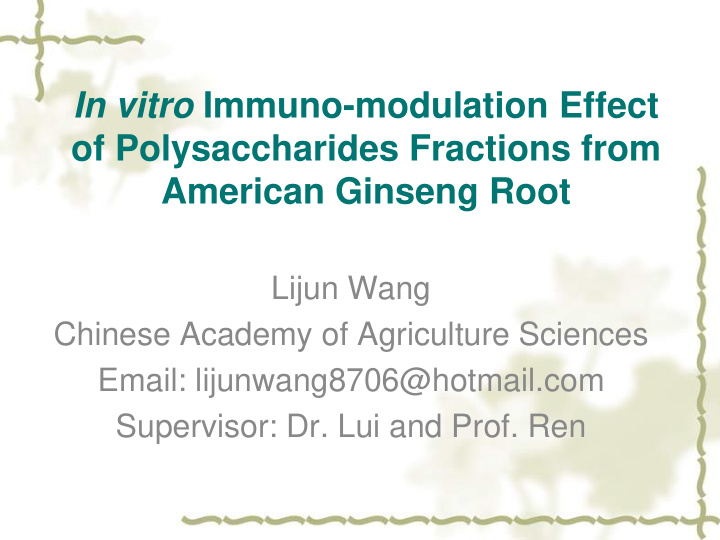



In vitro Immuno-modulation Effect of Polysaccharides Fractions from American Ginseng Root Lijun Wang Chinese Academy of Agriculture Sciences Email: lijunwang8706@hotmail.com Supervisor: Dr. Lui and Prof. Ren
Acknowledgement (1) Prof. Ren who supervised the project and provided me the opportunity to come here. (2) Dr. Lui who invite me to come and aided in the Pharmacological experimental design. (3) Miss Pei for her guidance in conducting my experiment.
1.Background • American ginseng ( Panax quinquefolius L. ) is one of the most recognized ginseng botanicals around the world. • Used as food, health food and drug for the pharmacological effects on the central nervous system, cardiovascular system, endocrine system, immune system and cancer. Usage of Ginseng Clinical Food Health Food (Traditional Chinese (Ginseng in Korea) (COLD-FX) Medicine)
Polysaccharides, 5-10%, gain more and more interest for it’s immuno-modulatory ( innate and adaptive) anti-tumor, anti-adhesive, antioxidant , hypoglycemic effects.
2.Objectives of my study (1) Extraction, purification and fractionation polysaccharides from American ginseng root Chemical structure identification : molecular weight, monosaccharides, spatial structure feature (NMR ). (2) Assay the immuno-modulatory effects of polysaccharide fractions on macrophages. Immuno-stimulation Anti-inflammation.
3. Experiment Design 3.1. Extraction, Purification and Fractionation Remove Starch ( 34%-42% ) Remove Water-soluble Protein Separate based on different molecule weight More PPQ1 was obtained (35.08%) (15.86%) 49% of the compositions were removed from PPQ with α -amylose and Sevag-reagent
3.2 Pharmacological Characterization
4. Result and Discussion 4.1 Anion Exchange Chromatography PPQ1 PPQ2 Wavelength 215nm for the detection of polysaccharides. Wavelength 280nm for the detection of protein. 20.60% 47.02% 17.44% 12.60% 40.55% 35.23% of PPQ1 was lose 25.98% of PPQ2 was lose PPQ2 had higher total yield ratio (74.02%) than PPQ2 (64.77%). More acidic fraction (47.33% ) in PPQ1 PPQ2.3 Maybe a glycoprotein for the high absorbance at 280 nm
4. Result and Discussion 4.2 In vitro immuno-stimulatory effect 4.2.1 Effect on the NO production PPQ1 was effective and the 35 Dose-Response curve was Nitrite Production ( μM ) PPQ1 30 linear with R 2 =0.9988. PPQ1.1(N) 25 PPQ1.2(A) Acidic fraction (PPQ1.2) was 20 y = 0.1179x + 3.061 Linear (PPQ1) 15 more effective than PPQ1 and 2 = 0.9988 R 10 neutral fraction (PPQ1.1) less 5 effective. 0 A similar result was got from 0 50 100 150 Dose (μg/mL) PPQ2 and it’s sub -fractions.
4. 2.2 Effects of PPQ1 and it’s sub -fractions on the cytokine production (a) TNF- α (b) IL -6 (c) IL-10 (d) IL- 1β PPQ1 and it’s sub -fractions had similar effects on this four cytokines ( TNF- α ,IL -6, IL-10 and IL- 1β) . Neutral fraction (PPQ1.1) was inactive. Crude fraction and acidic fraction up- regulated the production and acted in a concentration-dependent manner. There was no obvious difference between PPQ1 and acidic fraction PPQ1.2. IL- 1βproduction was very low compared with TNF- α ,IL -6, IL-10
4.3 Inhibition on LPS-stimulatory inflammation effect 4.3.1 Down-regulation on the NO production Nitrite production Not very obvious difference between PPQ1 and it’s acidic PPQ1 70 fraction PPQ1.2. PPQ1.1 Nitrite production (μM) 60 PPQ1.2 PPQ1 not acted in the linear way. 50 40 Although no effect on the 30 immuno-stimulatory effect 20 PPQ1.1 showed inhibition on 10 the LPS-stimulatory NO 0 production. 0 20 40 60 80 100 120 140 Dose ( μg/mL)
4.3.2 Down-regulation on cytokines production (a) TNF- α (b) IL -6 (c) IL-10 (d) IL- 1β Neutral fraction showed inhibition effects on the cytokine (TNF- α ,IL -6 and IL- 10 ) production but weaker than crude fractions and acidic fractions. The cytokine (TNF- α ,IL -6, IL-10) production dropped rapidly when the treatment concentration increased from 1μg/mL to 50 μg/mL.
5. Conclusion 1. DEAE-sepharose Fast Flow is effective in the fractionation. 2. More acidic fractions than neutral fractions in the AN ginseng root (1.75:1). 3. Acidic fractions were more active in immuo-modulation effects of macrophages than neutral fractions. 4.Although neutral fractions were inactive in the immuno-stimulation they still useful for displayed the inhibition against LPS-stimulatory inflammation. 5. Immuno-modulation activity of polysaccharides were affected by; Molecule weight, State of purity, Charge
Thanks for Your attendance!
Recommend
More recommend